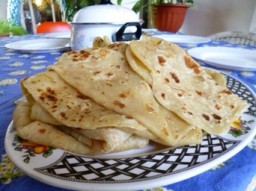
Dhall pooris (in french)
Ingrédients:
500 grammes de dholl,
750 grammes de farine,
2 cuil. à café de cumin (petit anis),
safran,
eau,
sel et poivre.
Notes: Personal tips received from Daniel Jose Marie:
“My mum (Marie Claude) and I practised making dahl purri this weekend with a lot of progress. I had a go on Sat night and it didn’t turn out right. Too hard and a bit like a pancake. But on Sunday, the result was great. I gave it 7/10 if compared to what you can buy at La Gare in Vacaos.
A few tips:
Cooking the split peas – no great secret there. Add some salt to the water and cook till soft enough to chew. Make sure you have a good grinder that will to pulverise the grain properly. A blender or food processor won’t do the trick. You need a coffee grinder or something as powerful. When ground, add quite a bit of anis & cumin. Of course this is to your taste.
For the dough, use the liquid from the dahl. Take care when adding salt to the flour because the liquid will be salty. Otherwise we made it just like paratas dough. We let it sit for 30mins and then kneaded it again just for 2 minutes or so. The real trick was putting the ground dahl in the ball of dough. First take a small ball of dough the size of a squash ball. Use both thumbs and make a pit in the middle (it’ll tend to shrink back). Put the dough with the pit in it in your left hand (I’m right handed). Put a spoon of ground dahl in the middle, and then use your left thumb to pack the dahl powder into the pit. Let the bottom of the pit expand through your left index and ring fingers. Add some more dahl and push again with your left thumb. When it feels like there enough dahl in there, close the pit by bringing all the edges of the pit together to a point and squeeze together. Keep squeezing and bringing up some dough from the sides up towards the centre on top of the ball.
Put the ball on a well-floured surface, flour the top a bit and roll till quite thin. You’ll see the spread of the dahl in the purri as it rolls out. If the spread looks uneven, keep going for this one and do better with the next lot.
For cooking: Brush oil on a pan at medium heat. Put the purri on the pan and brush the topside lightly with oil. For us what happened for the first time (after 10 or so goes) was that the purri started to bubble, and when we turned it over (after 15-20sec or so seconds), it kept puffing up like a soccer ball. Quite amazing to see.
Cook for only 15-20sec on each side. When cooked, store just like paratas – in a newspaper lined, sealed container.
We had it with chatini of tomate, ail, cotomilli, huile and some piment confit. The result was outstanding – texture, colour, flavour. Criticisms were they were a bit harder than usual DP’s and a tad too salty. Next time we are going to try less salt and less cooking time, otherwise very pleased indeed. Dewa here we come!
Good luck to anyone else that tries. Its a tradition that non-resident Mauritians can’t afford to lose.”
Daniel Jose Marie


Preparation:
Faites bouillir le dholl avec une pincée de safran et de sel jusqu’à ce qu’il soit cuit, mais faites attention qu’il ne colle pas. Passez-le et gardez l’eau pour l’utiliser après. Écrasez le dholl sans ajouter de l’eau.
Tamisez la farine en ajoutant du sel dans un bol. Travaillez la pâte avec l’eau que vous avez réservée. Pétrissez jusqu’à ce que la pâte devienne molle, sans coller. Emballez dans un fichu et laissez reposer la pâte pendant 1 heure. Ajoutez le cumin à la pâte ainsi qu’une pincée de sel si nécessaire.
Faites des petites boules de pâte pour enrouler dans les pooris. Avec un doigt, faites un trou au centre de chaque boule, puis placez une cuillère de dholl à l’intérieur. Fermez les boules en appuyant sur les côtés.
Enroulez les dans la farine, puis aplatissez-les, un à un, au rouleau à paâtisserie, pour en faire des cercles fins de pooris.
Chauffez une assez grande poêle, huilez l’intérieur et faites cuire les deux cotés de chaque poori.
Il ne faut pas laisser trop cuire sinon le poori sera dur.
Servir avec du chatini de pomme d’amour ou de coriandre (cotomili).

